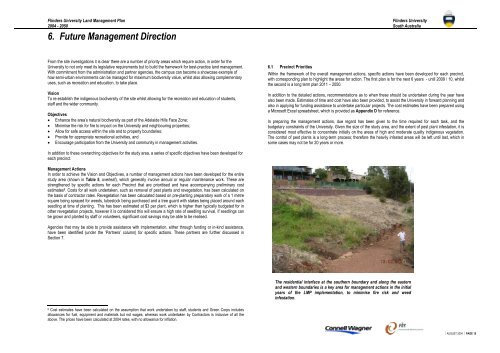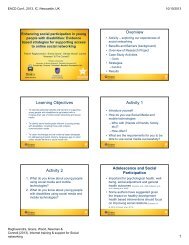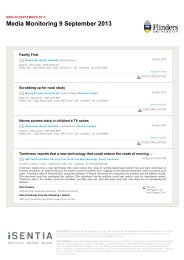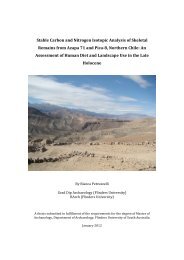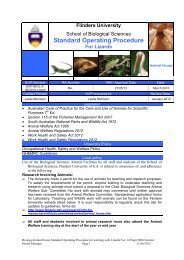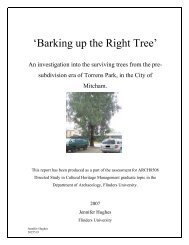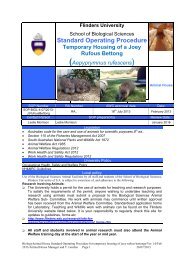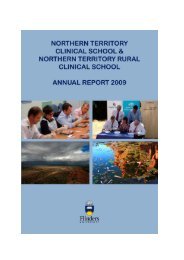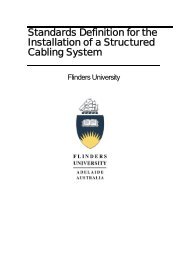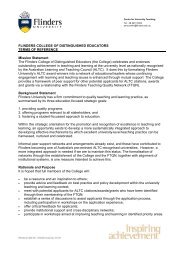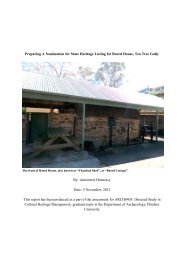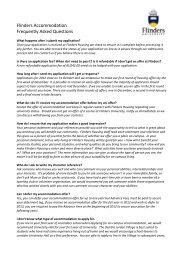Land Management Plan 2004 - 2050 Flinders University South ...
Land Management Plan 2004 - 2050 Flinders University South ...
Land Management Plan 2004 - 2050 Flinders University South ...
You also want an ePaper? Increase the reach of your titles
YUMPU automatically turns print PDFs into web optimized ePapers that Google loves.
<strong>Flinders</strong> <strong>University</strong> <strong>Land</strong> <strong>Management</strong> <strong>Plan</strong> <strong>Flinders</strong> <strong>University</strong><br />
<strong>2004</strong> - <strong>2050</strong> <strong>South</strong> Australia<br />
6. Future <strong>Management</strong> Direction<br />
From the site investigations it is clear there are a number of priority areas which require action, in order for the<br />
<strong>University</strong> to not only meet its legislative requirements but to build the framework for best-practice land management.<br />
With commitment from the administration and partner agencies, the campus can become a showcase example of<br />
how semi-urban environments can be managed for maximum biodiversity value, whilst also allowing complementary<br />
uses, such as recreation and education, to take place.<br />
Vision<br />
To re-establish the indigenous biodiversity of the site whilst allowing for the recreation and education of students,<br />
staff and the wider community.<br />
Objectives<br />
• Enhance the area’s natural biodiversity as part of the Adelaide Hills Face Zone;<br />
• Minimise the risk for fire to impact on the <strong>University</strong> and neighbouring properties;<br />
• Allow for safe access within the site and to property boundaries;<br />
• Provide for appropriate recreational activities, and<br />
• Encourage participation from the <strong>University</strong> and community in management activities.<br />
6.1 Precinct Priorities<br />
Within the framework of the overall management actions, specific actions have been developed for each precinct,<br />
with corresponding plan to highlight the areas for action. The first plan is for the next 6 years - until 2009 / 10, whilst<br />
the second is a long term plan 2011 – <strong>2050</strong>.<br />
In addition to the detailed actions, recommendations as to when these should be undertaken during the year have<br />
also been made. Estimates of time and cost have also been provided, to assist the <strong>University</strong> in forward planning and<br />
also in applying for funding assistance to undertake particular projects. The cost estimates have been prepared using<br />
a Microsoft Excel spreadsheet, which is provided as Appendix D for reference.<br />
In preparing the management actions, due regard has been given to the time required for each task, and the<br />
budgetary constraints of the <strong>University</strong>. Given the size of the study area, and the extent of pest plant infestation, it is<br />
considered most effective to concentrate initially on the areas of high and moderate quality indigenous vegetation.<br />
The control of pest plants is a long-term process; therefore the heavily infested areas will be left until last, which in<br />
some cases may not be for 20 years or more.<br />
In addition to these overarching objectives for the study area, a series of specific objectives have been developed for<br />
each precinct.<br />
<strong>Management</strong> Actions<br />
In order to achieve the Vision and Objectives, a number of management actions have been developed for the entire<br />
study area (shown in Table 5, overleaf), which generally involve annual or regular maintenance work. These are<br />
strengthened by specific actions for each Precinct that are prioritised and have accompanying preliminary cost<br />
estimates 8 . Costs for all work undertaken, such as removal of pest plants and revegetation, has been calculated on<br />
the basis of contractor rates. Revegetation has been calculated based on pre-planting preparatory work of a 1 metre<br />
square being sprayed for weeds, tubestock being purchased and a tree guard with stakes being placed around each<br />
seedling at time of planting. This has been estimated at $3 per plant, which is higher than typically budgeted for in<br />
other revegetation projects, however it is considered this will ensure a high rate of seedling survival. If seedlings can<br />
be grown and planted by staff or volunteers, significant cost savings may be able to be realised.<br />
Agencies that may be able to provide assistance with implementation, either through funding or in-kind assistance,<br />
have been identified (under the ‘Partners’ column) for specific actions. These partners are further discussed in<br />
Section 7.<br />
The residential interface at the southern boundary and along the eastern<br />
and western boundaries is a key area for management actions in the initial<br />
years of the LMP implementation, to minimise fire risk and weed<br />
infestation.<br />
8 Cost estimates have been calculated on the assumption that work undertaken by staff, students and Green Corps includes<br />
allowances for fuel, equipment and materials but not wages, whereas work undertaken by Contractors is inclusive of all the<br />
above. The prices have been calculated at <strong>2004</strong> rates, with no allowance for inflation.<br />
⏐ AUGUST <strong>2004</strong> ⏐ PAGE 15


